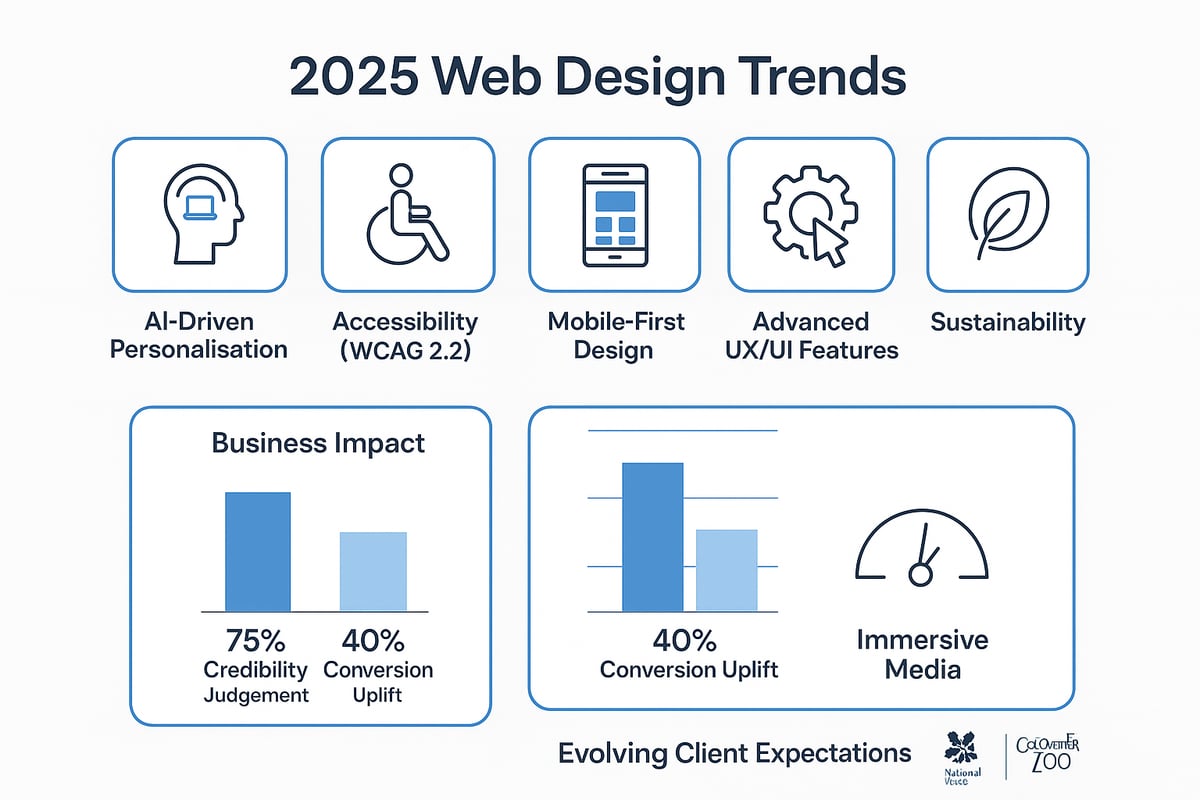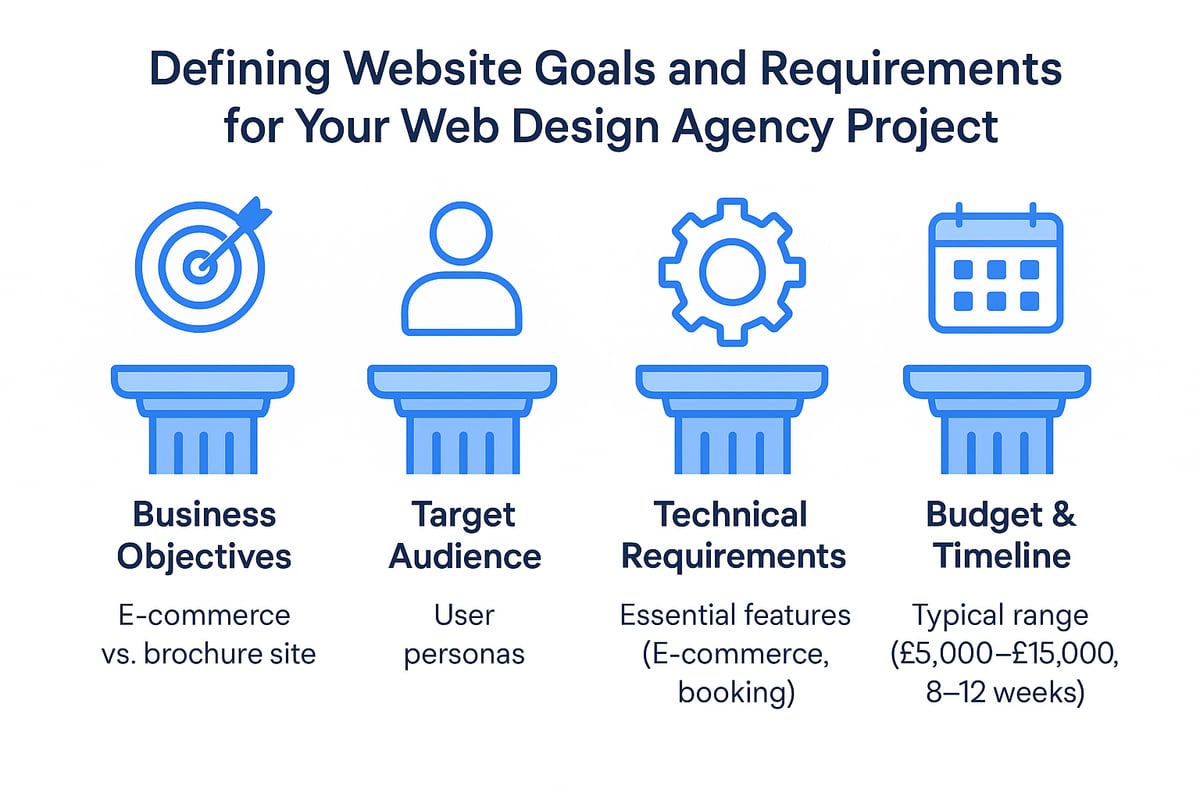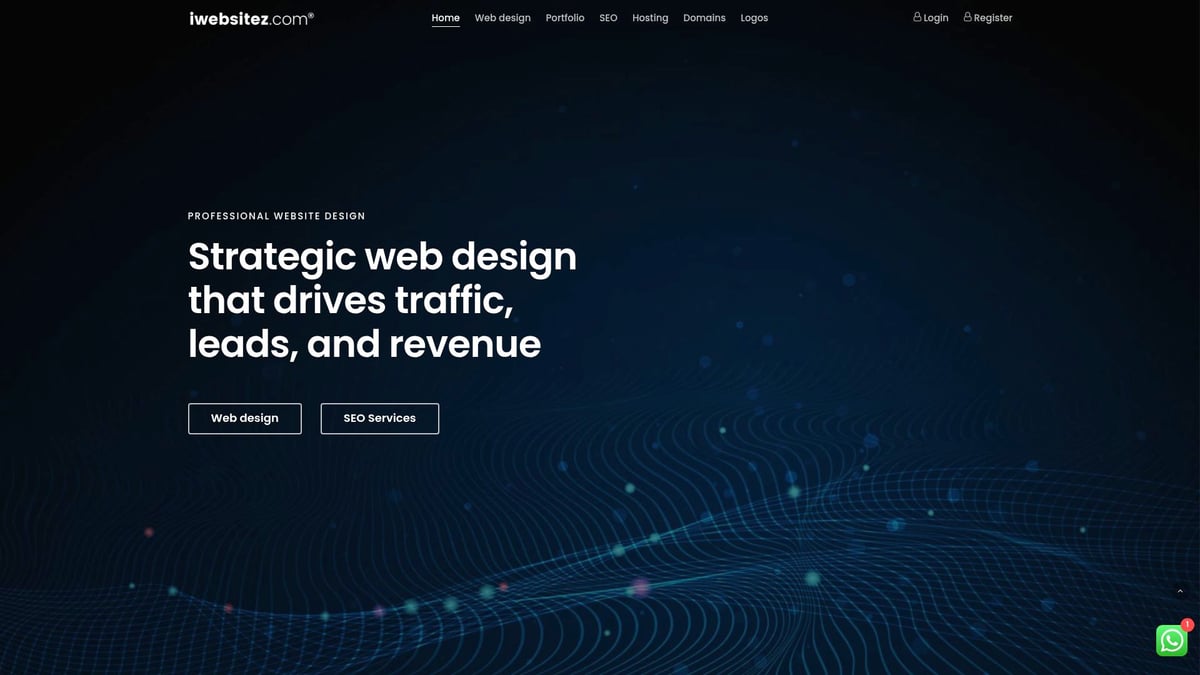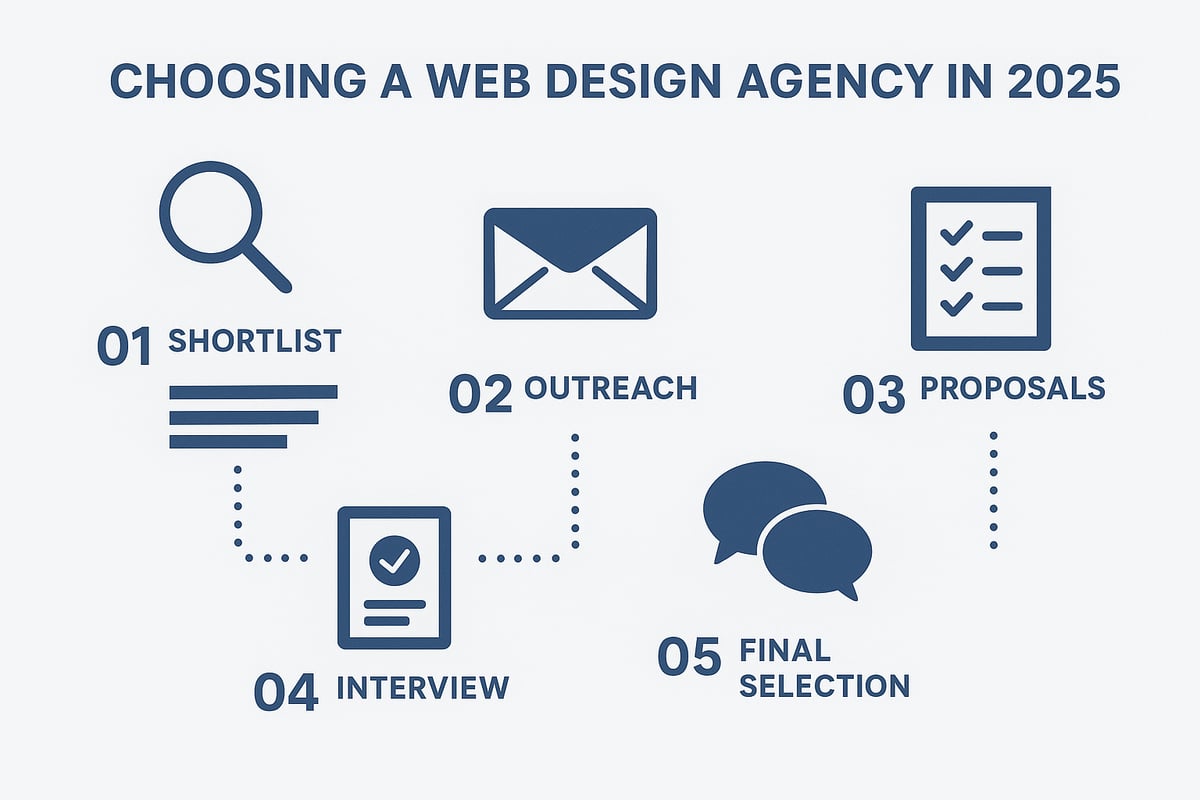In 2025, your digital presence is your business’s first impression. The right web design agency can determine whether you stand out or get lost in the crowd.
Website design is now more critical than ever, with fierce competition and fast-changing technology shaping every industry. Choose the wrong web design agency and you risk poor performance, wasted investment, and missed opportunities. Choose wisely and you unlock growth, credibility, and a loyal customer base.
This essential guide gives you practical steps, expert insights, and real-world examples to help you select a web design agency that fits your vision. Follow each section to make a confident, future-proof decision for your business.
Understanding the 2025 Web Design Landscape
Staying ahead in the digital world means understanding what shapes the future of your online presence. If you plan to partner with a web design agency in 2025, you need to know which trends, technologies, and expectations will define success. Let us guide you through the essentials.

Key Web Design Trends for 2025
The landscape for any web design agency is shifting rapidly, with 2025 set to introduce even more transformative trends. AI-driven personalisation will tailor content for each user, ensuring websites feel dynamic and relevant. Accessibility is now a must, with WCAG 2.2+ compliance becoming standard practice to serve all audiences equally.
Mobile-first and responsive design have moved from being best practice to non-negotiable. Advanced UX/UI features, such as micro-interactions and voice navigation, are elevating user engagement. Sustainable web practices, including green hosting and lightweight code, are increasingly important as businesses seek eco-friendly solutions.
Website speed is critical, with a target load time under two seconds influencing both search rankings and user satisfaction. Immersive media, like 3D visuals and AR elements, is making websites more interactive and memorable. For a deeper look at these emerging trends and supporting statistics, review the Web Design Trends for 2025.
| Trend | Benefit |
|---|---|
| AI Personalisation | Higher engagement, tailored content |
| Accessibility (WCAG 2.2+) | Broader audience, legal compliance |
| Mobile-First/Responsive | Improved reach, user satisfaction |
| Advanced UX/UI | Enhanced interactivity |
| Sustainability | Lower carbon footprint |
| Website Speed | Better SEO, higher conversions |
| Immersive Media | Memorable user experiences |
A web design agency must be fluent in these trends to deliver a future-proof site.
The Business Impact of Modern Web Design
Selecting the right web design agency can have a measurable effect on your business outcomes. According to recent data, 75% of users judge a company's credibility based on its website. A visually appealing and functional site not only builds trust but also drives conversion rates.
Improved UX can lead to a 40% boost in conversion rates, showing that even small changes in design and navigation can influence your bottom line. Google’s Core Web Vitals have become crucial ranking factors, making speed and performance non-negotiable for SEO in 2025.
A web design agency that prioritises these elements will help you achieve higher visibility in search results. Fast-loading pages, accessible layouts, and seamless mobile experiences are no longer optional if you want to outpace your competitors.
Investing in a modern, optimised site ensures your brand stands out. When you work with a web design agency that understands the latest standards, you position your business for sustainable digital growth.
Evolving Client Expectations
Client needs are evolving in tandem with technology. Businesses now expect their web design agency to offer more than just a one-time build. Proactive support and ongoing optimisation are at the heart of long-term partnerships.
Transparent communication is essential, with agencies expected to provide clear updates and measurable ROI. Clients are looking for agencies that act as digital partners, not just service providers.
Examples like the National Trust and Colchester Zoo show the value of investing in full-service digital collaborations. These organisations benefit from continuous improvement, data-driven insights, and a flexible approach to changing needs.
A modern web design agency should be committed to your success beyond launch. This means providing support, regular enhancements, and guidance as your business evolves in the digital landscape.
Defining Your Website Goals and Requirements
Establishing clear goals and requirements is the foundation for a successful partnership with a web design agency. By taking the time to clarify what you want to achieve, you ensure your investment delivers measurable results and supports your long-term growth.

Clarifying Your Business Objectives
Begin by identifying your primary business objectives. Are you aiming to generate leads, increase online sales, or boost brand awareness? The type of website you need will depend on your goals. For example, an e-commerce site requires robust product catalogues and secure payment gateways, while a brochure website focuses on showcasing services and building trust.
Aligning your website features with your core KPIs is essential. Consider how each element, from contact forms to booking systems, supports your targets. The right web design agency will help translate these objectives into a tailored digital strategy. For more insights into how e-commerce goals shape design, see these E-commerce Web Design Insights.
Understanding Your Target Audience
Knowing your audience is crucial for the success of any web project. Build detailed user personas and ideal client profiles (ICPs) to guide your decisions. Use tools like Google Analytics to analyse visitor demographics, behaviour, and preferences. Competitor research can reveal what works in your industry and highlight opportunities for differentiation.
Tailor your site’s design, content, and user experience to meet specific audience needs. A web design agency with expertise in your sector will use this data to create engaging, intuitive journeys that drive interaction and conversion.
Listing Functional and Technical Requirements
List all essential features your website must have. This includes e-commerce functionality, booking systems, CRM integrations, and content management system (CMS) preferences. Consider legal and ethical obligations such as accessibility and compliance with WCAG 2.2+ standards.
Scalability is also key. As your business grows, your site should adapt easily to new features or increased traffic. A web design agency will guide you through technical considerations to future-proof your investment.
Budget and Timeline Considerations
Set a realistic budget for your project. Professional websites often start from £700 to £1,200 or more, depending on complexity. Factor in additional costs like hosting, maintenance, and ongoing SEO to avoid surprises.
Understand typical project timelines, which can range from two to eight weeks. Discuss expectations with your web design agency early, including milestones and delivery dates. Clear budgeting and scheduling will help ensure your project stays on track and delivers value.
Key Criteria for Evaluating a Web Design Agency
Selecting the right web design agency is a pivotal decision for any business. With the digital landscape advancing rapidly, clear evaluation criteria will ensure your investment delivers both immediate and long-term results.
Portfolio and Proven Results
A reputable web design agency should showcase a diverse portfolio that reflects both style and industry experience. Review their previous work to see if it aligns with your brand and objectives. Look for measurable outcomes, such as increased conversion rates or improved mobile performance.
When reviewing portfolios, consider:
- Range of industries covered
- Evidence of results (e.g., 65% mobile conversion improvement)
- Types of websites delivered (e-commerce, B2B, non-profit)
Examining case studies and measurable results provides insight into the agency’s ability to deliver value. For more advice on evaluating agency portfolios and making informed comparisons, see this guide on choosing a web design company.
Technical Expertise and Service Range
A skilled web design agency offers a comprehensive range of services, from design and development to SEO and ongoing maintenance. Assess whether services are delivered in-house or outsourced, as this can affect quality and support.
Key areas to evaluate include:
- Technology stack (WordPress, custom CMS, e-commerce platforms)
- Breadth of services (SEO, content creation, hosting)
- Experience with integrations and scalability
A full-service web design agency ensures your website is built for both current needs and future growth, providing technical stability and adaptability.
Process and Communication
The project process and communication style of a web design agency can significantly impact your experience. Look for agencies that conduct thorough onboarding and discovery phases, ensuring a deep understanding of your goals.
Strong agencies will:
- Use collaborative tools (moodboards, wireframes)
- Encourage regular feedback cycles
- Offer transparent project management and updates
Clear, consistent communication throughout the project lifecycle builds trust and helps keep your project on track.
Reputation, Reviews, and References
A web design agency’s reputation is best reflected by client reviews, testimonials, and long-term partnerships. Check Google and Clutch review scores, aiming for agencies with consistently high ratings.
Ask for references and speak with past clients to verify:
- Quality of work delivered
- Reliability and responsiveness
- Lasting value from the partnership
Positive feedback and repeat business signal an agency’s commitment to client satisfaction.
Cost Transparency and Value
Transparent pricing is essential when choosing a web design agency. Reputable agencies provide clear proposals with detailed breakdowns of deliverables, timelines, and ongoing costs.
| Criteria | Value-Based Agency | Low-Cost Provider |
|---|---|---|
| Upfront pricing | Clear | Often unclear |
| Hidden fees | None | Possible |
| Ongoing support | Included | Limited/extra |
Value-based pricing considers the quality and scope of services, not just the lowest price. Always clarify amendment policies and support terms before signing.
Support and Ongoing Maintenance
Ongoing support is a hallmark of a reliable web design agency. Post-launch services such as updates, security, and performance optimisation ensure your website remains effective and secure.
Evaluate:
- Availability of the support team
- Maintenance plans and SLAs
- Responsiveness to urgent issues
A dedicated support partnership can safeguard your online presence and help you adapt to evolving business needs.
iwebsitez.com: A Case Study in Full-Service Digital Partnership
iwebsitez.com exemplifies what to look for in a web design agency. Their approach covers custom design, SEO, hosting, and ongoing support under one roof. With a proven track record, including a 98% client satisfaction rate and up to 40% increase in online sales, they demonstrate the impact of a results-driven, transparent partnership.

Serving over 100 businesses, iwebsitez.com prioritises long-term relationships and measurable outcomes. Their value-based pricing and commitment to ongoing optimisation set a benchmark for agencies in 2025.
Step-by-Step Process for Choosing the Right Agency
Selecting the right web design agency requires a structured, methodical approach. By following a clear process, you can minimise risk and maximise the likelihood of a successful partnership. Each step below is designed to help you make a confident, informed decision that aligns with your business goals.

Step 1: Shortlisting Potential Agencies
Begin by researching both local and national web design agency options. Use online directories, client referrals, and review platforms to gather a broad list. Evaluate each agency's expertise, industry experience, and service offerings.
Create a shortlist by reviewing portfolios and case studies. Focus on agencies with proven results in projects similar to your needs. Look for diversity in their work, such as e-commerce, B2B, and non-profit websites.
Organise your findings in a table for easy comparison:
| Agency Name | Industry Focus | Services Offered | Notable Results |
|---|---|---|---|
| Agency A | E-commerce | Design, SEO, Hosting | 60% conversion lift |
| Agency B | B2B | Design, Content, CMS | 35% traffic growth |
| Agency C | Non-profit | Full-service | 90% satisfaction |
Narrow your list to those agencies that align with your project scope and values.
Step 2: Initial Outreach and Discovery
Once you have a shortlist, prepare a detailed project brief outlining your business objectives, target audience, and technical requirements. Share this with each web design agency to gauge their initial response.
Assess agency responsiveness and communication style. Prompt, clear replies are an early indicator of professionalism. Schedule discovery calls or meetings to discuss your project in depth.
Use this stage to determine if the agency asks insightful questions and shows enthusiasm for your vision. Agencies invested in understanding your goals will likely deliver a more tailored solution.
Keep notes on each agency's communication quality and willingness to collaborate.
Step 3: Evaluating Proposals and Quotes
After discovery sessions, request detailed proposals from each web design agency. Compare scope of work, deliverables, timelines, and cost structures.
Look for clear breakdowns of services, including design, development, SEO, and ongoing support. Distinguish between custom solutions and template-based offerings. Evaluate the transparency of pricing and any ongoing costs.
Consider using a checklist to compare proposals:
- Does the agency address your specific requirements?
- Are timelines realistic and well-defined?
- Is ongoing support included?
- Are there clear terms for revisions and amendments?
Select agencies whose proposals demonstrate value, clarity, and alignment with your business needs.
Step 4: Interviewing and Due Diligence
Interviewing shortlisted agencies is crucial. Prepare strategic questions about their process, in-house team, and previous projects. Ask for references and review case studies to verify claims.
During interviews, assess cultural fit and shared values. Understanding how an agency operates behind the scenes can reveal their approach to quality and client satisfaction. For deeper insights, explore resources like How to start a web design agency, which shed light on agency workflows and service delivery.
Speak with past clients to learn about their experiences. Check online reviews for consistency in feedback. This due diligence helps avoid surprises and ensures you partner with a reputable agency.
Step 5: Making the Final Selection
With all information gathered, weigh your options carefully. Consider each web design agency's expertise, communication, value, and overall fit with your company culture.
Negotiate terms to clarify deliverables, payment schedules, and project milestones. Ensure all expectations are clearly documented in a contract.
Before signing, confirm you are comfortable with the agency’s approach and support structure. Setting the right foundation now will contribute to a smoother project and long-term success.
A thoughtful, step-by-step process empowers you to select a web design agency that not only meets your needs today but also supports your growth in the years ahead.
Red Flags and Common Pitfalls to Avoid
Selecting the right web design agency is a critical decision that can shape your brand’s digital future. However, many businesses encounter setbacks by missing early warning signs or falling into common traps. Knowing what to watch for will help you make a more informed, confident choice.
Warning Signs When Evaluating Agencies
When reviewing a web design agency, certain red flags should immediately prompt caution. Transparency is paramount; agencies that are vague about pricing or deliverables often create confusion and hidden costs later. Overpromising results, such as guaranteed top search rankings, is unrealistic and may signal questionable practices.
Be wary of portfolios filled with outdated styles or sites that are not mobile responsive. Communication is another key factor. If your initial queries are met with slow responses or unclear answers, expect similar issues throughout your project.
- Lack of transparent pricing or deliverables
- Unrealistic promises about results
- Outdated or non-responsive design examples
- Poor or inconsistent communication
- Negative or missing client reviews
- Heavy reliance on third-party plugins, which can limit scalability
A trustworthy web design agency will always provide clarity, up-to-date work, and prompt, open communication.
Common Mistakes by Clients
Clients can inadvertently hinder project success by making avoidable mistakes. One frequent error is choosing a web design agency solely based on the lowest price rather than overall value. This can lead to subpar results and higher long-term costs.
Failing to define clear goals and requirements at the outset often results in a website that does not align with business objectives. Overlooking the need for ongoing support and maintenance is another pitfall, as websites require regular updates to perform optimally.
- Focusing only on cost instead of value and expertise
- Not outlining specific goals, KPIs, or technical requirements
- Ignoring the importance of post-launch support
- Skipping reference checks or not reviewing case studies
- Overlooking the cultural and communication fit with the agency
To avoid these pitfalls, approach your web design agency selection as a strategic partnership rather than a one-off transaction.
Examples and Lessons Learned
There are numerous real-world examples highlighting the risks of neglecting due diligence. Businesses have experienced significant drops in website traffic and sales after poor SEO migrations managed by inexperienced agencies. Slow-loading websites can severely impact conversions, with every extra second of load time causing up to a 7% decrease in conversion rates, as shown by key User Experience Design Statistics.
Regular updates, security checks, and proactive support are essential for long-term digital success. When a web design agency provides ongoing optimisation and transparent communication, clients see better results and fewer costly setbacks.
By staying alert to these red flags and learning from common mistakes, you can choose a web design agency that will drive sustainable growth and measurable impact for your business.
Maximising Value from Your Web Design Agency Partnership
Building a successful relationship with a web design agency goes far beyond the initial launch. To ensure you receive lasting value, it is essential to establish clear expectations, foster a collaborative environment, and continually optimise your website for ongoing business growth.
Setting Expectations and Goals
Begin your partnership by defining measurable KPIs and success metrics. Discuss these with your web design agency from the outset to ensure alignment. Typical goals include increasing website traffic, boosting conversion rates, or improving brand awareness.
Use analytics tools to track progress post-launch. Agree on regular reporting intervals so you can monitor performance together. This shared understanding creates accountability and sets a clear direction for the agency relationship.
Building a Collaborative Relationship
Open, ongoing communication is the backbone of any strong web design agency partnership. Set up regular check-ins to discuss feedback, share updates, and address challenges early.
Encourage your agency to share their expertise and suggest improvements proactively. A collaborative approach ensures your website continues to evolve in line with your business goals. When both sides are invested in the process, results are consistently stronger.
Ongoing Optimisation and Support
Continuous improvement is essential for maintaining a high-performing website. Your web design agency should offer regular SEO, content updates, and technical maintenance. This includes monitoring site speed, fixing bugs, and keeping up with search engine requirements.
For additional guidance, you can refer to resources about SEO-focused web design agencies, which highlight the importance of integrating SEO and ongoing support into your partnership. Scheduling routine reviews keeps your site secure, up-to-date, and competitive.
Planning for Future Growth
A forward-thinking web design agency will help you plan for scalability and new features as your business evolves. Discuss your long-term vision and ensure your site’s architecture can accommodate future needs.
Stay informed about trends and best practices to keep your site relevant. Consider agencies with a track record of long-term partnerships, as seen with leading firms supporting brands through multiple growth phases.
Measuring ROI and Business Impact
Measure the true value of your web design agency partnership by tracking increases in traffic, conversions, and sales. Use data-driven insights to inform future decisions and optimise your digital strategy.
Regularly reassess the agency’s fit as your business changes. With the right approach, your partnership will deliver measurable impact and support your ongoing success.
